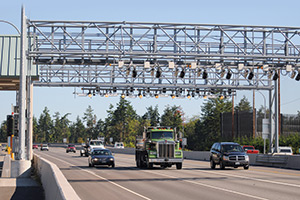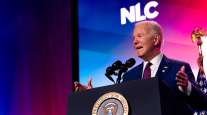Senior Reporter
Toll Supporters See Opportunity in Trump Infrastructure Pledge

This story appears in the Dec. 19 & 26 print edition of Transport Topics.
If President-elect Donald Trump’s campaign pledge to tap private investors to build infrastructure projects over the next 10 years is adopted by Congress, new tolling facilities are likely to take off along busy freight corridors, tolling proponents and several transportation groups said in recent interviews with Transport Topics.
Over the next few years, the Trump administration and the Republican-led Congress will begin rewriting a highway law that would authorize surface transportation.
During the campaign, Trump promised to establish a $1 trillion investment in infrastructure over 10 years through $137 billion in tax credits. In 2015, President Obama enacted the five year FAST Act highway law, which keeps the federal Highway Trust Fund solvent through 2021.
Tolling firms, road builders, transit authorities, the state highway directors, environmental groups, truckers, unions and corporations have indicated they will push their funding priorities in the next highway bill. If they accept that Congress and the White House will oppose increasing federal fuel taxes, the groups will be forced to choose other funding options, several transportation experts said. Tolling is among those options.
Aware of the looming national debate on infrastructure funding, Patrick Jones, CEO of the International Bridge, Tunnel and Turnpike Association, established a truce of sorts within Washington’s diverse transportation lobby. On Nov. 30, Jones said he gathered the leaders of nearly two dozen transportation groups for a private meeting in Washington to find common ground on highway funding.
Jones’ group argues revenue from tolling would help cash-strapped cities and states build large roadway projects. On the flip side, freight and trucking executives continue to oppose tolling facilities that either hinder commerce or are developed along existing interstates.
Speaking to Transport Topics shortly after the meeting, Jones said his peers acknowledged there “probably are a handful of key principles that this group could agree on, that we could rally around.”
And, he added, “We ought to articulate and define what those key principles are.”
Jones called the Nov. 30 gathering the Transportation Visioning Summit. He prompted the groups to visualize the infrastructure network they would like to see three decades down the road, and participants agreed that policymakers need to start piecing together new freight and passenger corridors for future generations.
“I think there was a palpable level of frustration, or maybe concern, that there’s a lot of partisanship in Washington and it’s difficult to get the president and the Congress on the same page, or even all the members of the Congress on the same page. So people are really looking for leadership and vision,” Jones said.
According to a list obtained by Transport Topics, the groups at the IBTTA gathering were: the I-95 Corridor Coalition, Mileage Based User Fee Alliance, American Road and Transportation Builders Association, Associated General Contractors of America, the American Society of Civil Engineers, Truck Renting & Leasing Association, ITS America, the American Association of State Highway and Transportation Officials, American Trucking Associations, U.S. Travel Association, American Association of Motor Vehicle Administrators, American Public Transportation Association, American Automobile Association, National Asphalt Pavement Association, American Bus Association, the Transportation Research Board, and Building America’s Future.
ATA President Chris Spear attended the summit.
“With respect to tolling, that will certainly be part of the debate with respect to P3s — public-private partnerships,” Spear said, noting tolling along rural corridors often does not produce the requisite vehicle traffic to generate meaningful returns for investors.
And, if tolling existing roads and bridges is proposed, Spear added: “We’re going to fight that until the end.”
Despite Jones’ best intentions to build solidarity, Spear’s line in the sand on existing interstates already was crossed by another group that was at the summit.
A week after the gathering, Ed Rendell, Building America’s Future co-chairman and former governor of Pennsylvania, said at an event in Washington that tolling existing interstates is exactly what states should consider.
“Private sector is not going to get involved without a reasonable rate of return. Tolling is a way to do that,” Rendell said at an event hosted by The Atlantic. “Let the states toll if they want to toll.”
Marcia Hale, president of Building America’s Future, attended the IBTTA summit.
“We’ve always been in favor of bringing the private sector in. Our thought would be to start a national infrastructure bank, which would be a way to vet projects all around the country and then help bring the private sector in,” Hale told TT.
“What we really need also is improved federal funding, and we need a guaranteed revenue source to improve federal funding, and that is what is most needed with our problems — trying to maintain what we have and then actually build a 21st-century infrastructure in this country,” Hale added.
Jones plans to host a similar summit in a few months.
“There seemed to be an agreement or a consensus that, ‘Hey, we should do this again. We should get together more often.’ There’s always a benefit in the conversation,” Jones said.




